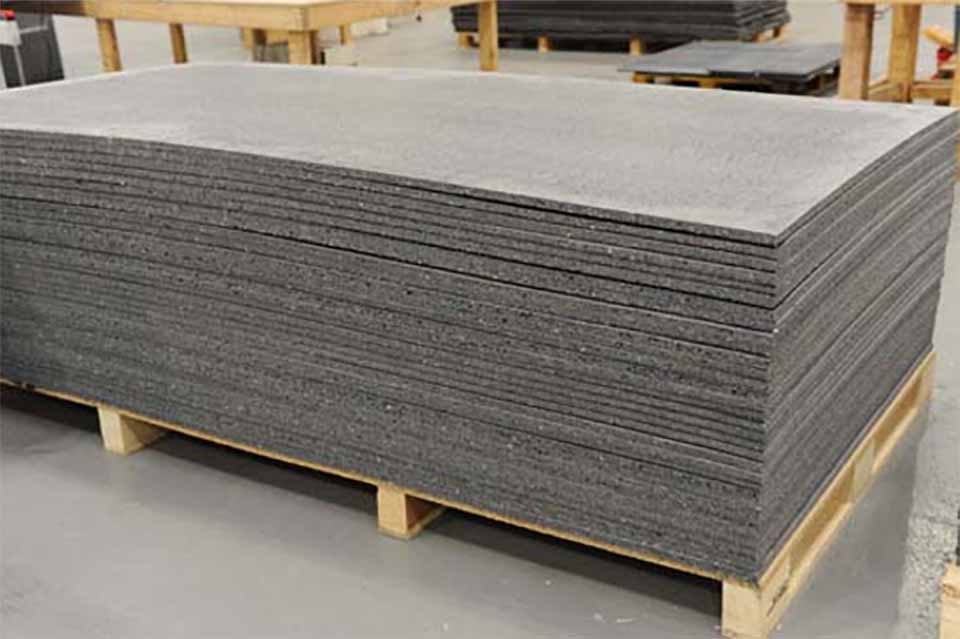
RePolyTex is gearing up to operate its Madison, N.C. facility at full scale, manufacturing a “plastic plywood” product from shredded e-plastics. | Courtesy of RePolyTex.
A U.S. plastics recycling and manufacturing facility is preparing to begin taking in plastics recovered from electronics. The plant will use that feedstock to produce construction materials.
RePolyTex is gearing up to operate its Madison, N.C. facility at full scale, with project leaders anticipating the facility will begin test production in the coming weeks. The plant will bring in a variety of shredded plastics recovered from electronics, and it will use those materials to manufacture a “plastic plywood” product suited for a range of construction applications.
The project is being carried out in partnership with Synergy Electronics Recycling, which operates an electronics processing plant near the RePolyTex facility. Once running, RePolyTex will take all of the shredded e-plastics Synergy recovers from printers, fax machines and other e-scrap devices.
“We want the low-grade, plastic-rich material,” said Jason Price, president of Synergy.
Lee Clayton, chief technology officer for RePolyTex, said the quality of Synergy’s e-plastic is part of what drew him to the project. Synergy produces “a great base material to work from,” he explained.
Besides RePolyTex and Synergy, TwoRivers ITAD Solutions is an additional investor in the project. Based in a 40,000-square-foot facility in Lithonia, Ga., TwoRivers collects, refurbishes and recycles computer equipment.
The project was one of several materials recovery efforts that received a recent grant from the North Carolina Department of Environmental Quality.
Process has a ‘wide bandwidth’ for input quality
Synergy will send between 300,000 and 400,000 pounds per month of common resins to the RePolyTex site. These plastics typically include ABS, PC, HIPS and more.
At RePolyTex, the material will go through a cleaning process to remove any remaining metals or other contaminants that are embedded in plastic components. That can include a self-tapping screw at the core of a piece of plastic, for example.
Once free of contaminants, the plastics will be blended together into specific formulations to suit the need of the application feedstock. “The more you can blend the product, the better,” Clayton said.
The blend goes through what Clayton described as a fusion encapsulation process, and it goes into molds of various designs. Clayton explained that the process is “a bit more forgiving” than a blow molding or a sheet extrusion process.
“We’ve created a process with quite a wide bandwidth” in terms of feedstock quality, he explained.
The product will be available for a variety of building projects and is particularly suited for applications that are exposed to the elements. For example, one potential buyer sought out the product for weather-resistive barriers. And the RePolyTex team offered the example of the material being used to replace outdoor wooden steps in parks.
“Anything wet, damp, outside, that normally would use another material that rots, this would be a great substitution for that,” Price said.
The facility has a capacity to produce 100,000 RePolyPly sheets per year, each weighing about 60 pounds. But the RePolyTex system is modular and can easily expand to meet demand growth, Clayton said. The process is also designed to be available to “bolt on” at other facilities, including any type of operation generating the scrap plastics.
Having a dedicated outlet for e-plastics helps Synergy avoid the constantly shifting export landscape.
“That’s what we’re excited about – we’re controlling our own destiny,” Price said. “Having this market is a big game-changer for Synergy.”
To receive the latest news and analysis about plastics recycling technologies, sign up now for our free monthly Plastics Recycling Update: Technology Edition e-newsletter.
More stories about processors
- Ohio startup creates end market for small challenging plastics
- Major plastic initiative sets sights on system change
- California will fund mixed plastics facility, other projects